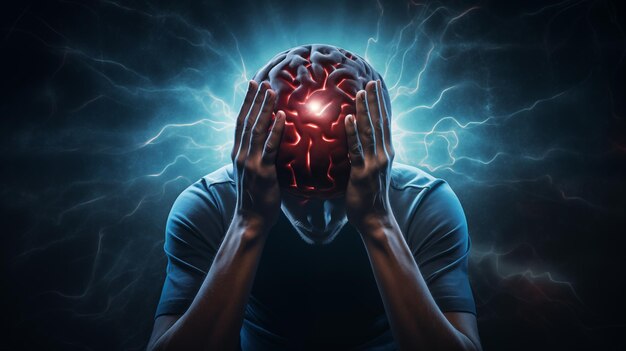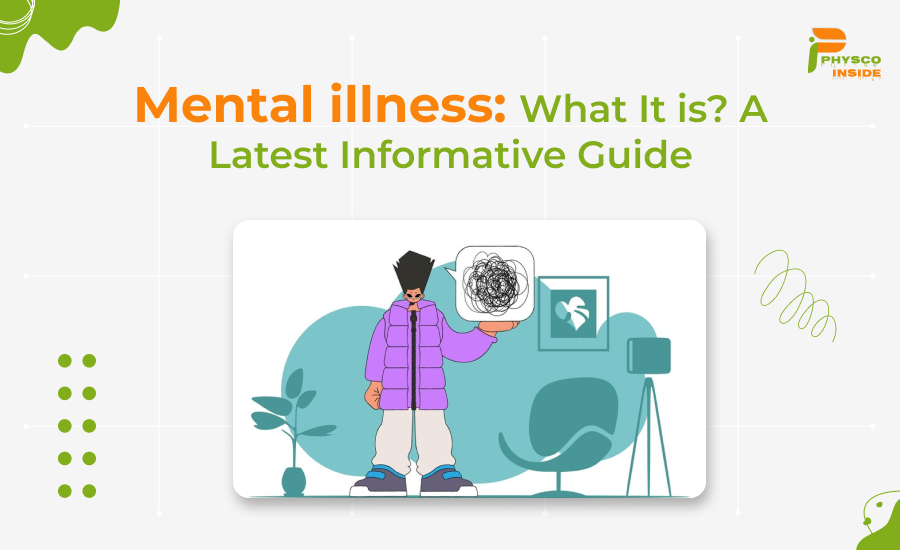(1) Introduction:
Mental Illness is a complex and general Phenomenon. It Surrounds a wide range of conditions that affect thoughts, emotions, and behaviors. As society Increasingly recognizes its impact, understanding mental health issues becomes Essential. I am Authoring this article. This article gives you all the information about “Mental Illness.” This Presentation Explores the Definition and Significance of mental illness. It leads to an Examination of its Historical context, Classification, causes, and treatment Approaches. By Shedding light on this topic, we aim to promote awareness and empathy towards those affected.
(2) Definition:
“Mental Illness refers to a range of mental health conditions that affect mood, thinking, and behavior, causing significant Distress or Impairment in daily functioning”.
Examples include Depression, anxiety Disorders, Schizophrenia, and eating Disorders. Treatment Typically Involves medication and therapy.
(3) What is the Importance of understanding Mental illness?
Understanding mental illness is crucial due to several factors:
- (3.1) Promotes Early Recognition and Treatment: Detecting symptoms early can lead to timely Intervention. It improves Outcomes and reduces the strength of the illness.
- (3.2) Reduces Stigma: Educating people about mental health can help reduce the shame and Separation Associated with mental illness. It Encourages more individuals to seek help without fear of judgment.
- (3.3) Improves Quality of Life: Proper understanding and management of mental health conditions can enhance the quality of life. Those individuals are affected by mental Instability, Enabling them to lead fulfilling lives.
- (3.4) Enhances Support Systems: Awareness among family, friends, and Communities can create a Supportive environment. It is essential for the recovery and health of individuals with mental health issues.
- (3.5) Informs Public Policy and Resource issues: Increased Awareness can influence Policymakers to allot resources fairly and develop wide mental health services and programs.
- (3.6) Promotes Research and Development: Greater Awareness and understanding drive research efforts. It leads to Advancements in treatment options and a deeper knowledge of mental health issues.
- (3.7) Improves Social and Economic Outcomes: Effective management of mental illness can reduce the social and Economic burdens Associated with Untreated mental health conditions. For example, Unemployment, Homelessness, and Healthcare costs.
- (3.8) Promotes Overall Health: Mental health is essential to overall health. Understanding and Addressing mental health issues can prevent physical health conditions and improve overall Prosperity.
- (3.9) Empowers Individuals: Knowledge about mental health enables individuals to take control of their mental health. It seeks help when needed and engages in Self-Care practices.
- (3.10) Fosters Compassion and Empathy: Understanding Psychological Instability turns Compassion and empathy toward those affected. It promotes a more Supportive society.
(4) What is the Impact of Mental illness on Society?
Mental illness affects 1 in every 5 adults worldwide, leading to significant personal Distress and Societal burden. It Contributes to Disability, reduces Productivity, and increases healthcare costs. Shame and lack of access to treatment increase these issues. It highlights the need for wide mental health support and public Awareness of its Widespread impact.

(5) What is the Global prevalence of Mental Illness?
- According to the survey, 25 % of the global population is affected by mental illness including men, women, and children.
- In Pakistan, Approximately 34% of adults are affected by Mental illness.
(6)What are the Types of Mental illness?
There are six (6) main types of Mental illness.
- (6.1) Temperament Problems: Mental health issues, such as Depression and Bipolar Disorder, involve constant mood changes. It affects daily Functioning and quality of life.
- (6.2) Anxiety Problems: Anxiety Disorders, such as Generalized Anxiety Disorder and panic Disorder. It causes Uncontrolled worry or fear that interferes with daily activities.
- (6.3) Psychotic Problems: Psychotic Disorders, like Schizophrenia, disrupt thinking, Perception, and emotions. It leads to mistakes, Hallucinations, and Impaired Social Functioning.
- (6.4) Behavioral Conditions: Behavioral conditions, including Borderline Personality Disorder and Self-Loving Personality Disorder. It Involves patterns of behavior, Cognition, and inner experience that vary from social Expectations.
- (6.5) Neurodevelopmental Issues: Neurodevelopmental Disorders such as autism Spectrum Disorder and ADHD are expressed early in childhood. It impacts social Interaction, communication, and behavior.
- (6.6) Substance Use Issues: Substance use Disorders, including alcohol use Disorder and drug use Disorder. It Involves harmful forms of Substance use leading to significant Distress.
(7) What are the Causes or Risk factors of “Mental illness”?
To know about the Causes and Risk Factors of Mental Illness, read the following information
(7.1) Genetic Factors:
Unbalanced behaviors can run in families, suggesting a genetic Component.
(7.2) Biological Factors:
- Brain Chemistry: Irregularities in Neurotransmitters can influence mood and behavior.
- Hormonal Imbalances: Chemical changes can affect mental health, especially in conditions like Postpartum Depression.
(7.3) Environmental Factors:
- Childhood Trauma: Abuse, neglect, or loss during childhood increases the risk of developing mental health issues.
- Disturbing Life Events: Events like divorce, job loss, or the death of a loved one can trigger mental illness.
(7.4) Psychological Factors:
- Mental Patterns: Negative thinking patterns can Contribute to Depression and anxiety.
- Personality Traits: Qualities like Perfectionism or low Self-esteem can influence individuals to mental health issues.

(8) What are the Common Symptoms of Mental Illness?
The Common Symptoms of Mental illness are Following:
- (8.1) Emotional Symptoms: Constant sadness, Baseless fears, mood swings, and feelings of Worthlessness.
- (8.2) Behavioral Symptoms: Changes in behavior such as taking away from social activities. It changes in eating or sleeping patterns, and Increased use of Substances.
- (8.3) Physical Symptoms: Unexplained aches and pains, fatigue, and significant changes in weight or Appetite.
(9) How can mental illness be Diagnosed?
Diagnostic Criteria for Mental Illness are:
- (9.1) DSM-5 (Diagnostic and Statistical Manual of Mental Disorders): This method is used by Healthcare professionals to Diagnose mental Disorders. It provides normal Guidelines and Classifications for various mental health conditions.
- (9.2) ICD-10 (International Classification of Diseases): This is a global standard for Diagnostic Criteria, developed by the World Health Organization. This covers all health issues including mental and Behavioral Disorders.
(10) What are the Treatments of Mental Illness?
Mental Illness can be treated or managed by understanding the following points:
(10.1) Psychotherapy:
- Cognitive Behavioral Therapy (CBT): Focuses on changing negative thought patterns and behaviors. It helps patients develop coping plans for dealing with various issues.
- Psychodynamic Therapy: Explores unconscious feelings and past experiences to understand and resolve current mental issues. It aims to increase Awareness and understanding of the impact of the past on present behavior.
- Dialectical Behavior Therapy (DBT): Combines CBT with Mindfulness techniques. It is particularly effective for treating Borderline Personality Disorder and Involves teaching skills for Managing emotions. It improves relationships and reduces Impulsive behaviors.
(10.2) Medication:
- Antidepressants: Used to treat Depression, anxiety, and other mood Disorders. They work by Adjusting chemicals in the brain, such as Serotonin and Norepinephrine.
- Antipsychotics: Treat conditions like Schizophrenia and bipolar Disorder by Modifying the effects of Neurotransmitters in the brain, particularly Dopamine.
- Mood Stabilizers: Used Primarily for bipolar Disorder to prevent mood swings and secure mood over the long term.
(10.3) Lifestyle Modification:
- Diet and Exercise: Healthy eating and regular physical activity can improve mood and overall mental health. Exercise releases Endorphins, which are natural mood lifters.
- Sleep Hygiene: Establishing a regular sleep schedule and creating a Relaxing sleeping environment for mental Well-Being. Poor sleep can increase mental health issues.
(10.4) Support Systems:
- Support Groups: Provide a safe space for individuals to share experiences and receive support from others facing similar challenges. They can be led by a professional or a peer.
- Family and Friends: Having a support network of loved ones can offer emotional support, Encouragement, and practical help. They can also help in Recognizing symptoms and Encouraging treatment.
(11) What are the Barriers to the Treatment of Mental illness?
Following are the Barriers to the Treatment of Mental illness:
- (11.1) Dishonor and Favoritism: Negative attitudes and Misconceptions about mental health issues can prevent individuals from seeking help. Then its results are that individual Socially cutoff and face Rejection.
- (11.2) Access to Care: Limited Availability of mental health services, particularly in rural or Underserved areas, hinders access to necessary treatment.
- (11.3) Cost of Treatment: High Expenses connected with treatment, medication, and Hospitalization can be Excessive. It is especially for those without Suitable insurance coverage.
- (11.4) Cultural and Social Barriers: Cultural beliefs and Societal norms may Discourage individuals from seeking mental health care. Some fear judgment, and misunderstanding within their community.
(12) What are the Awareness programs for Mental Illness?
Following are the Awareness programs for Mental illness:
(12.1) Early Intervention Programs:
These programs aim to identify and address mental health issues in their early stages. By Providing timely support and treatment, they can prevent the process of mental Illnesses. Examples include Assessment programs in schools and primary care Settings, as well as community Outreach efforts.
(12.2) Public Awareness Campaigns:
These campaigns seek to educate the public about mental health, reduce shame, and promote understanding. They use media, public service announcements, and community events to spread information about Recognizing symptoms. It seeks help and support for those with mental health conditions.
(12.3) School and Workplace Capability:
Programs in schools and Workplaces focus on creating Supportive environments. Schools may offer mental health education, Counseling services, and stress management Workshops. Workplaces can Implement employee assistance programs (EAPs). This provides mental health resources and promotes a balance between fun and serious activities to support employees’ mental Well-Being.

(13) What are the 10 best Preventive Tips for mental illness?
Managing mental illness can be challenging, but there are practical steps that can help to manage symptoms and improve overall health.
- (13.1) Seek Professional Help: Consult a mental health professional such as a doctor, Therapist, or counselor to obtain a proper Diagnosis and treatment plan.
- (13.2) Follow a Treatment Plan: Attach to direct medications and treatment sessions. Consistency is important in Effectively Managing mental health conditions.
- (13.3) Practice Self-Care: Engage in activities that promote Relaxation and Well-being, such as taking a bath, reading, or spending time in nature.
- (13.4) Maintain a Healthy Lifestyle: Eat a Balanced diet, exercise regularly, and get Sufficient sleep. These factors significantly impact mental health.
- (13.5) Stay Connected: Build and maintain support networks of family, friends, and support groups. Social connections can provide Meaningful support and reduce feelings of Loneliness.
- (13.6) Learn Stress Management Techniques: Practice Mindfulness, Meditation, or yoga to manage stress levels. Techniques like deep breathing exercises can also be helpful.
- (13.7) Set Realistic Goals: Break tasks into smaller, Achievable steps and set Achievable goals. Celebrate small Victories to build confidence and Motivation.
- (13.8) Educate Yourself: Learn about your mental health condition to better understand it and recognize symptoms. Knowledge Empowers you to Effectively manage your illness.
- (13.9) Avoid Substance Abuse: Guide clear of drugs and Excessive Alcohol Consumption. As they can increase mental health conditions and slow treatments.
- (13.10) Engage in Enjoyable Activities: Follow hobbies and interests that bring pleasure and happiness. Participating in Enjoyable activities can improve mood and provide a sense of purpose.
These steps can provide a Structured approach to Managing mental illness. It promotes a Supportive environment and improves overall mental health.
(14) Conclusion:
Overall, Addressing Unstable behavior requires a wide approach that includes understanding, Compassion, and action. By Reducing the Dishonor around mental health, Improving access to care, and Highlighting Prevention and Early Intervention. We can create a society where individuals feel Supported and allowed to seek help. It is important to recognize that mental illness is not a sign of weakness but a condition that deserves attention and treatment. Through Collaboration among states, Communities, and individuals, we can promote a culture of Acceptance and support. It also ensures better mental health outcomes for all.
(15) Frequently Asked Questions (FAQs)
Mental illness refers to conditions that affect thoughts, emotions, and behaviors. It often causes distress or harms everyday functioning.
Common types include depression, anxiety disorders, bipolar disorder, schizophrenia, and eating disorders.
Mental illness is diagnosed through opinions by mental health professionals based on symptoms and their impact on daily life.
Treatment options include therapy (such as CBT), medication (such as antidepressants), lifestyle changes, and support groups.
Risk factors include genetics, trauma, stress, substance abuse, and environmental factors.
Offer empathy, listen non-judgmentally, encourage professional help, and provide practical support and understanding.


